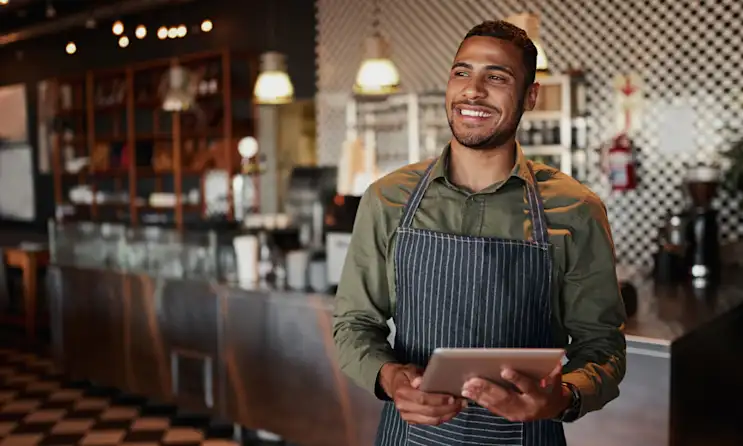Marketing
A Beginner's Guide to Restaurant Email Marketing
November 2, 2022
Find out why you should be using email in your marketing efforts, the first five steps to complete and best practices for success.
Picture this: you have a custom-built website that’s mobile-friendly and brings your brand to life, you’re posting regularly on your social media accounts and you’ve optimized your Google My Business listing. You’ve created a great online presence, and now you want to level up with more advanced marketing tactics. Where should you start?
Email marketing is a natural next step to explore. It puts you in direct contact with diners — unlike social media, for example, which requires you to navigate through an algorithm in order to be seen. And no, email isn’t dead or outdated. In fact, it’s easy to track and measure the effectiveness of this channel.
Why Should Restaurants Use Email Marketing?
Email marketing can become an important part of your overall marketing strategy. If you’re not currently leveraging this channel and aren’t sold on the value of it, here are three statistics that will change your mind.
1. Email marketing is more likely to drive revenue than social media. 60% of consumers say they’ve made a purchase as the result of a marketing email they received compared to only 12.5% of consumers who would make a purchase from social media. For restaurants, a purchase can be considered things like an online order, gift card, restaurant merchandise or tickets to a wine dinner.
2. The average ROI of email marketing is high. Data shows that for every dollar spent on email marketing, $36 is earned back. Some reports indicate the median email marketing ROI is 122% — that’s four times higher than any other digital marketing channel. Restaurants have tight margins, so it’s imperative that money spent on marketing is spent wisely. Email marketing is a proven cost-effective channel.
3. Automated emails based on diner behavior can build stronger guest relationships. Restaurants can use automated email campaigns to send past online ordering customers a special offer or discount as an incentive to order again. Automated email campaigns drive an average of $96 in revenue for each click on a marketing email and create a 247% increase in repeat diners. New York City’s Loring Place, for example, generated more than $8,000 in revenue from just one campaign.
How To Launch Your Email Marketing Plan
It might feel overwhelming to kick off your email marketing efforts from scratch. If you’re at a loss for where to begin, read on. Below, you’ll find a handful of steps to get you started, insight on what to include in your emails and an overview of best practices.
The First 5 Steps To Complete
So you’ve decided to create an email marketing plan for your restaurant — congrats! Before you start sending anything and showing up in inboxes, here are five steps you should take to set yourself up for success.
Select an email service provider. You need technology to power your emails, and finding an email software tool is an essential first step. There are many options in the marketplace but Emma, Campaign Monitor, MailChimp and Constant Contact are some of the top platforms to consider.
Place an “Email Sign Up” button on your website. Capturing email subscribers on your restaurant’s website is simpler than it sounds. You can place a call-to-action (CTA) button like “Email Sign Up” on your navigation bar or in the footer. You’ll need to connect the sign up button to your email software — talk to your website provider for details.
If you want to add intrigue and creativity to your CTA to improve conversions, play around with different language. For example, Brooklyn restaurant Gertie uses the playful phrase “Gertie Gossip” as the email sign up prompt in their side navigation. Explore a few options that fit best for your concept. You can even run an A/B test where you implement two choices and see which performs best.Send a welcome email to new subscribers. Think of an email signup like a knock on your front door from a new friend. How would you respond? By opening up the door and greeting them, of course. That’s what a welcome email can be: a warm hello. The email doesn’t need to be complicated. You can thank your new subscriber for signing up and share more about your restaurant. Consider adding a discount code as a thank you for subscribing or sharing a welcome message from your chef or owner.
Understand email metrics. There’s no need to memorize an entire glossary of terminology, but here are a few key terms you should know.
Open rate - This is the percentage of people who open an email from you. Say you have an email list of 1,000 subscribers. If you send an email campaign that 400 people open, your open rate is 40%. MailChimp has a helpful table of email marketing benchmarks across industries. For restaurants, the average open rate is 19.77%.
Click rate - This is the percentage of people who click a link in your email out of the total number of subscribers who received the email. 35 clicks from your 1,000 subscriber list would be a 3.5% click rate. That might sound low, but the average click rate for restaurants is 1.34%.
Click through rate - Depending on your email marketing software provider, the term “click through rate” may be used instead or in addition to “click rate.” The difference here is that this is the percentage of people who click on a link in your email out of the total number of subscribers who opened the email (not the total number of subscribers who received the email). Remember, not everyone who you send an email to will open it.
Unsubscribe - This is when someone opts out of receiving emails from you. Expect to have unsubscribes from each email campaign you send — in fact, the average unsubscribe rate for restaurants is 0.28%. However, this is a number to keep an eye on. Some unsubscribes are anticipated, but a high amount could be a sign that your emails aren’t connecting with your audience.
Hard bounce - This means that the email cannot be delivered. Typically, it’s because the email address does not exist (either a subscriber entered a fake email address or misspelled their email address). Valid email addresses may also block your email campaigns due to firewall or filter restrictions. An average hard bounce for restaurants per email campaign is 0.37%.
Soft bounce - This means that an email is experiencing a temporary delivery issue. Reasons why this can happen include: someone’s mailbox is full, an email server is down or an email is too large.
Start with a weekly email. Once you’ve selected an email software, started capturing subscriber information, set up a welcome email and learned a few key terms, it’s time to send your first email campaign! Figuring out a frequency and cadence that’s both manageable for your team and engaging for guests is crucial, but this takes time. Begin with a weekly email, if possible, and go from there.

PRODUCT
Email Marketing for Restaurants
Want to build guest relationships with marketing automation? Trigger emails based on diner behavior to drive repeat revenue.
What To Include in Your Emails
Once your first five steps are completed, it’s time to decide what exactly to include in your emails. It’s simpler than you might think to come up with content ideas. Here are a few suggestions to supercharge your brainstorming.
Announce new menu items. Launching a new seasonal menu? Share the news with your email subscribers. Make sure to include food photos to visually show the dishes and share descriptions as well.
Offer discount codes. This is one of the most popular ways to re-engage past customers. For example, you can offer 15% off your next online order as a way to encourage repeat orders. With automated email marketing, it’s easy to set up emails that are triggered based on diner behavior.
Invite guests to restaurant events. Hosting a cooking class? Offering a wine dinner? Ticketed events are a great revenue driver for restaurants, and proper marketing of the events is imperative. Use your email list to create awareness for these happenings and boost ticket sales.
Promote gift cards. Gift cards make great gifts any time of year, but there may be a few times when you want to more actively promote this offering. Sending an email reminding your subscribers of this gift idea during the holidays or ahead of Father’s Day and Mother’s Day keeps you top of mind.
Celebrate customer birthdays. If you collect a subscriber’s birthday during the signup process, you can send them a celebratory message on their special day. While a simple note with well wishes is a nice gesture, pairing a birthday message with a discount or offer (like a free appetizer or dessert) goes a long way in creating customer loyalty.
Share a recipe from your kitchen team. An online order or in-person dining experience isn’t the only way for your email subscribers to stay connected to your food. Providing a recipe as an exclusive piece of content in your emails is a way to build a relationship with customers — you’re essentially saying, here’s a link between our kitchen and yours.
Feature your chef. Pull back the curtain and show your subscribers who’s behind the swinging door. More and more, diners are interested in learning about the people who make their food. You can include a headshot, bio and fun Q&A with your chef to increase their visibility among potential and current customers.
Tell the story behind the restaurant’s most popular dish. Is your restaurant known for a particular meal? Do you have data on the most ordered dish? Share details on how the menu item was developed.
Unveil new restaurant merchandise. Mugs, hoodies, cookbooks, packaged foods and t-shirts are some of the most popular restaurant merchandise to sell. Fans of your restaurant might not even realize you sell these branded items. Pop into their inbox to let them know and drive revenue that’s easily tracked.

PRODUCT
Turn Your Website Into a Revenue Generator
Create your digital storefront for online ordering, catering, gift cards, merchandise, events and more.
Restaurant Email Marketing Best Practices
After nailing down the basics and brainstorming content ideas for upcoming email campaigns, become familiar with the best practices for email marketing. As you start sending emails and get to know your audience better, you can develop customized protocols and guidelines that work for you. For now, here are eight tips to follow.
Keep your opt-in process simple. Opt-in is another term for signing up. It’s the way new subscribers give you permission to send them emails. As a general rule, the less information you request on a sign up form, the better the chances of converting someone to a subscriber. Ideally, keep your fields simple to include First Name, Last Name and Email Address. However, if you’re planning to send a birthday message to email subscribers, make sure to ask for that as well.
Comply with the CAN-SPAM Act. The CAN-SPAM Act is a law that was passed in 2003 that sets certain rules for businesses using email marketing. You can find the full details here but the key takeaways are that you must include a valid physical postal address in the email and have an unsubscribe option. All email software providers will have these required elements already in their templates, but it’s good to understand the regulations.
Use a short, enticing subject line. MailChimp recommends less than 60 characters (9 words) while Marketo’s analysis shows that less than 41 characters (7 words) performs best. The underlying theme is that short subject lines win. Follow MailChimp and Marketo’s general guidelines, but experiment with character/ word counts and explore A/B testing to determine what works for your audience. Do keep in mind that mobile devices typically display the first 25-35 characters of a subject line.
Keep your email length short. With marketing emails, brevity is king. To keep your message streamlined and succinct, decide a theme or main outcome for your email. Is the goal to sell restaurant gift cards on Cyber Monday? Are you trying to increase online orders? Do you have a handful of remaining tickets for a special tasting menu? Choose one promotion per email campaign and only share the most relevant information.
Have a clear call-to-action (CTA) button. Hyperlinks throughout your email can support your messaging, but it’s imperative that you have a well-designed, visually pleasing CTA button at the end of your message. A CTA button is important because it signals to your subscribers what they should do next. It’s also very easy to find and click when scanning the email quickly. Use a short phrase (are you sensing a theme?) as your call-to-action like Check Out the New Menu, View Open Positions, Order Now, Download the Recipe or Book Your Table.
Be mindful of frequency. In “The First Five Steps to Complete” section, we recommended starting with a weekly email. Sending more than one email per week may annoy your email list and lead to a higher number of unsubscribes. You can use an email template to plan out your communications and plot email campaigns around upcoming promotions. Looking ahead through spreadsheet planning can help you identify how often you’re sending and where you might need to adjust.
Use appetizing food photography. Lastly, make your food front and center in your email. Good food photography brings your email marketing to life, especially if your email is announcing a new menu or special dish.

PRODUCT
Build With BentoBox
Get a beautifully designed website with tools to grow your restaurant.
Where To Start & Quick Links
Now that you know the benefits of email marketing, here’s a list of recommended email software providers, tools to support your new efforts and free courses to learn from.
Email Marketing Software
Email Marketing Tools
Free Email Marketing Courses

BentoBox Marketing & Commerce Platform
Deliver Smarter Hospitality
Want to stand out online, bring in more money, engage your diners, and streamline operations?
Recommended

Marketing
How Restaurants Should Use Instagram in 2024
June 29, 2022
Instagram remains the most important social platform for restaurants. Here’s how to find success.

Marketing
How to Write a Restaurant Marketing Plan [Free Template]
June 24, 2021
Help your restaurant stand out and appeal to more guests with this in-depth marketing plan template.

Marketing
8 Easy Steps to Improve Your Restaurant SEO
March 10, 2023
Learn some best practices that restaurants can use to boost their local search rankings online and get more guests through the doors.


